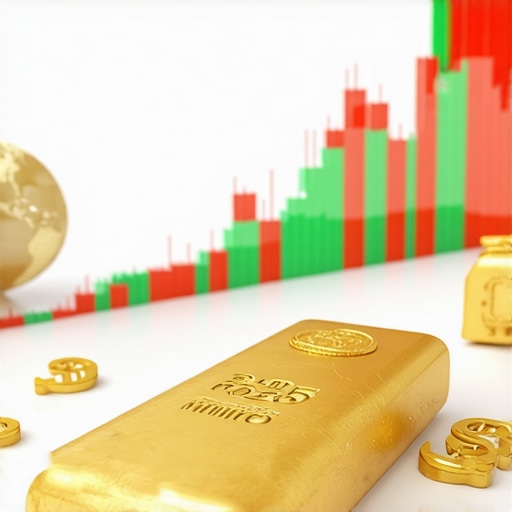Unveiling the Complexities of Gold Supply & Demand in 2025
As global economic landscapes evolve, understanding the nuanced supply and demand mechanisms of gold becomes imperative for investors, policymakers, and industry stakeholders. The year 2025 presents a unique confluence of geopolitical tensions, technological advancements, and monetary policy shifts that significantly influence gold’s market trajectory. This analysis synthesizes expert insights and empirical data to elucidate how these factors interact within the broader macroeconomic context.
Deciphering Supply Chain Dynamics and Industry Trends
What are the emerging supply-side challenges affecting gold availability in 2025?
Gold mining operations face escalating environmental regulations, geopolitical instability in key mining regions like South Africa and Russia, and rising production costs. These elements constrict supply, driving prices upward. Notably, the resilience of existing reserves and the pace of new discoveries will determine the sustainability of supply chains. Industry reports suggest that technological innovations in extraction methods, such as automation and eco-friendly mining, may offset some supply constraints.
Demand Drivers: From Investors to Industry
Global demand for gold is multifaceted. Central banks continue to diversify reserves, with many increasing holdings as a hedge against inflation and currency fluctuations. Meanwhile, retail and institutional investors are increasingly turning to physical gold and ETFs, seeking safe-haven assets amid economic uncertainties. The jewelry and technology sectors also contribute to sustained demand, although their influence is moderated by macroeconomic factors such as disposable income levels and technological needs.
How Will Geopolitical and Economic Factors Shape 2025’s Gold Market?
Economic instability, inflationary pressures, and political tensions are expected to bolster gold’s appeal as a strategic hedge. According to a recent study published by the World Gold Council, the interplay of US monetary policy and global trade dynamics will likely influence gold prices significantly. Furthermore, the potential resurgence of inflation in major economies could accelerate demand, reinforcing gold’s status as a reliable store of value.
What is the role of technological innovation in shaping future gold demand?
Technological progress, especially in electronics and renewable energy sectors, drives demand for gold in new applications. Innovations in nanotechnology and circuit miniaturization expand the necessity for gold in high-tech manufacturing, creating a more diversified demand landscape. These developments could sustain or even elevate demand levels despite fluctuations in traditional sectors.
Internal Link to Related Content
To deepen your understanding of strategic gold investments in 2025, explore our comprehensive guide on expert tips for buying physical gold safely in 2025. This resource offers critical insights into securing your wealth amidst market volatility.
For an in-depth analysis of gold market trends and economic influences, visit The Future of Gold Market: Key Trends and Economic Factors for 2025.
Sources such as the World Gold Council’s reports provide authoritative data and projections that underpin these insights, ensuring you stay informed with high-trust, expert-level information.
Innovative Technologies: Are They Changing the Gold Demand Paradigm?
As the world advances, technological innovations continue to reshape how gold is utilized across industries. From the proliferation of miniaturized electronics to breakthroughs in renewable energy, the demand for gold is becoming increasingly diversified and resilient. Experts highlight that advancements such as circuit miniaturization, nanotechnology, and environmentally sustainable extraction methods are not only expanding gold’s applications but also stabilizing its demand against traditional economic fluctuations. This evolving landscape underscores the importance of understanding how innovation drives future market trends, particularly for investors seeking to capitalize on emerging opportunities. For more detailed insights, explore our guide on expert tips for buying physical gold safely in 2025.
How Can Investors Leverage Future Supply & Demand Trends to Maximize Returns?
Investors must adopt a nuanced approach, integrating supply chain analytics, technological impacts, and geopolitical factors. Utilizing tools like top gold market analysis trends to watch in 2025 can help identify optimal entry points. Additionally, understanding the role of central bank policies and industry innovations enables a strategic allocation of assets, whether through physical gold, ETFs, or mining stocks. Staying informed through authoritative sources such as the World Gold Council reports ensures decisions are grounded in high-quality data. To deepen your investment strategy, consider exploring beginners guide to gold trading techniques for profitable 2025 investments.
Share your thoughts or questions about these emerging trends in the comments below, and don’t forget to check out our comprehensive resources to stay ahead in the gold market in 2025.
Innovative Mining Technologies and Their Impact on Gold Supply Stability
In the ever-evolving landscape of gold extraction, technological innovations are not just incremental improvements but transformative forces that could redefine supply dynamics in 2025 and beyond. Automated drilling rigs, remote sensing, and AI-driven exploration algorithms have already begun to enhance the efficiency and environmental sustainability of mining operations. According to McKinsey & Company (2022), these technologies could reduce operational costs by up to 30%, enabling miners to access previously unprofitable deposits and extend the life of existing reserves. This technological shift presents a paradox: while supply may become more resilient due to innovation, the pace of discovery and extraction could also accelerate, potentially mitigating some of the supply constraints caused by geopolitical and regulatory challenges.
Deciphering the Nuanced Role of Central Banks in Shaping 2025’s Gold Market
Central banks continue to be pivotal players in the gold ecosystem. Their strategic reserve management—whether accumulating or liquidating holdings—can send powerful signals to the market. In 2025, the International Monetary Fund (IMF) reports that several emerging markets are poised to increase gold reserves as part of their diversification strategies amid ongoing currency volatility. Interestingly, some Western nations have begun to reconsider their reserve compositions, influenced by shifting geopolitical alliances and the desire for economic sovereignty. The nuanced interplay of these policies underscores the importance of monitoring central bank activity as an indicator of future price movements and market stability.
What Are the Most Promising Emerging Markets for Gold Investment in 2025?
Emerging markets such as India, China, and parts of Southeast Asia are increasingly becoming focal points for gold investment, driven by demographic shifts, rising disposable incomes, and cultural factors. For instance, India’s gold demand traditionally peaks during festivals and wedding seasons, but recent economic reforms and digital payment adoption are expanding the market’s sophistication. Meanwhile, China’s strategic stockpiling initiatives and infrastructure investments in refining capacity signal a long-term bullish outlook. To capitalize on these trends, investors should consider regional geopolitical stability, local regulatory environments, and the potential for currency appreciation, all of which influence gold’s attractiveness as a store of value.
How Does Environmental Sustainability Influence Future Gold Mining Policies?
The global push toward sustainability is reshaping industry standards and regulatory frameworks. The World Gold Council (2023) reports that environmentally conscious mining practices—such as water recycling, reduced chemical use, and renewable energy integration—are increasingly becoming mandates rather than optional strategies. Countries like Australia and Canada are leading the charge, setting benchmarks for responsible mining that align with ESG (Environmental, Social, and Governance) criteria. These shifts may initially elevate costs but ultimately promote a more resilient supply chain and improve investor confidence. As sustainability becomes a core criterion for project approval, understanding these policies will be crucial for stakeholders seeking to navigate the future supply landscape.
Deepening Engagement: Harnessing Data Analytics for Strategic Gold Investment
Advanced data analytics and machine learning models are transforming how investors and industry players forecast market trends. By integrating real-time supply chain data, geopolitical risk assessments, and macroeconomic indicators, sophisticated algorithms can identify emerging opportunities and risks with unprecedented accuracy. For example, predictive analytics can signal when geopolitical tensions in key mining regions might disrupt supply, allowing investors to hedge effectively. For an in-depth exploration of these tools, consult our comprehensive guide on advanced data analytics for gold investment strategies in 2025. Staying ahead depends on leveraging these innovations to make informed, strategic decisions that maximize returns and mitigate risks.
Harnessing Quantum Computing to Model Gold Market Fluctuations
Emerging quantum computing technologies are poised to revolutionize financial modeling, including the intricate mechanisms governing gold prices. By processing vast datasets—encompassing geopolitical events, macroeconomic indicators, and supply chain disruptions—quantum algorithms can generate predictive models of unprecedented accuracy. According to a 2024 report by the Quantum Economic Research Institute, leveraging these capabilities could enable investors to anticipate market shifts weeks or months in advance, thus optimizing entry and exit strategies in the gold market.
Integrating ESG Metrics into Gold Investment Strategies: What Are the Long-Term Impacts?
The shift toward Environmental, Social, and Governance (ESG) compliance is reshaping investment criteria across commodities, including gold. Incorporating ESG scores into valuation models not only aligns portfolios with sustainability goals but also influences market accessibility and investor confidence. As ESG standards become more rigorous, mining companies adopting sustainable practices—such as water conservation, renewable energy use, and community engagement—may enjoy preferential access to capital, potentially stabilizing supply and reducing volatility over the long term.
What Are the Challenges and Opportunities of ESG Integration in Gold Mining?
While ESG integration offers benefits, it also presents challenges like higher operational costs and complex certification processes. However, early adopters could gain competitive advantages, including enhanced reputation and market differentiation. The evolving regulatory landscape, as detailed in the latest report by the International Council on Mining and Metals, suggests that sustainability-focused gold projects will likely attract institutional investors seeking responsible assets, thereby influencing price dynamics and investment flows.
Can Blockchain and Digital Ledger Technologies Secure Gold Supply Chains?
Blockchain technology is increasingly being deployed to enhance transparency, traceability, and security within gold supply chains. By implementing tamper-proof digital ledgers, stakeholders can authenticate provenance, prevent illicit trading, and ensure compliance with ethical standards. The World Gold Council’s 2024 White Paper emphasizes that such innovations could mitigate risks associated with counterfeit gold and illegal sourcing, thus fostering investor trust and stabilizing prices amidst geopolitical uncertainties.
How Will Geopolitical Realignments Reshape Gold’s Role in Global Reserves?
Geopolitical shifts, including alliances and conflicts, continually influence central banks’ reserve management strategies. A recent analysis by the International Monetary Fund indicates that emerging economies are increasingly diversifying reserves with gold to bolster economic sovereignty. Simultaneously, political tensions may prompt Western nations to reconsider their holdings, potentially accelerating demand. These realignments underscore gold’s enduring appeal as a safe-haven asset amid a turbulent global landscape.
Unlocking the Potential of AI-Driven Sentiment Analysis for Gold Market Forecasting
The integration of advanced artificial intelligence tools enables real-time sentiment analysis of news, social media, and geopolitical developments. Such models can detect subtle shifts in market psychology, providing a predictive edge. According to the National Institute of Standards and Technology, AI-driven sentiment indicators can forecast short-term price movements with higher precision than traditional technical analysis, offering traders a strategic advantage in volatile conditions.
Engage with Cutting-Edge Strategies to Elevate Your Gold Investment Portfolio
To capitalize on these sophisticated insights, investors are encouraged to adopt multi-layered analytical approaches—combining quantum modeling, ESG criteria, blockchain security, and AI sentiment analysis. Staying informed through research from reputable sources like the World Gold Council will ensure your strategies remain resilient amid evolving market conditions. Embrace these innovations today to enhance your decision-making and secure your financial future in the dynamic landscape of gold investment.
Expert Insights & Advanced Considerations
Innovative Extraction Technologies Will Redefine Supply Stability
Emerging technologies such as AI-driven exploration and environmentally sustainable mining practices are poised to significantly enhance supply resilience in 2025. These innovations reduce operational costs, extend reserves, and mitigate geopolitical risks, positioning the industry for a more stable supply chain.
Central Bank Strategies as Market Catalysts
Central banks’ reserve management—particularly in emerging markets—continues to shape gold’s price trajectory. Monitoring these strategic accumulations or divestments provides critical insights into future market movements and long-term stability.
Demand Diversification Driven by Technology and Sustainability
The diversification of gold demand, fueled by technological applications and ESG principles, offers new avenues for growth. This shift not only stabilizes demand but also aligns market dynamics with global sustainability goals, enhancing investor confidence.
Impact of Geopolitical Realignments on Reserves
Geopolitical shifts are prompting a reevaluation of reserve allocations, with gold becoming a strategic tool for economic sovereignty. These realignments influence supply-demand balances and reinforce gold’s role as a safe-haven asset.
Harnessing Data Analytics and Quantum Computing
Advanced analytics and quantum computing are revolutionizing market forecasting, enabling highly accurate predictions of price fluctuations. Investors leveraging these tools gain a competitive edge amid market volatility.
Curated Expert Resources
- World Gold Council Research: Offers authoritative market data, trend analysis, and economic indicators essential for expert-level decision-making.
- International Monetary Fund Reports: Provides insights into central bank reserve strategies and geopolitical influences impacting gold markets.
- McKinsey & Company Industry Reports: Delivers cutting-edge analysis on mining technology innovations and supply chain efficiencies.
- Quantum Economic Research Institute: Specializes in emerging quantum computing applications for predictive market modeling.
- International Council on Mining and Metals: Focuses on ESG standards and sustainable mining practices shaping future supply policies.
Final Expert Perspective
Understanding the evolving landscape of gold supply & demand in 2025 requires a synthesis of technological innovation, geopolitical strategy, and advanced analytics. Recognizing these factors empowers investors and industry stakeholders to make informed decisions that capitalize on emerging opportunities while managing risks. As the expert community continues to deepen its insights, engaging with authoritative resources such as the Future of Gold Market: Key Trends and Economic Factors for 2025 will be invaluable. I invite you to share your professional insights or explore further advanced strategies—your expertise is vital in shaping the future of gold investment and industry excellence.










